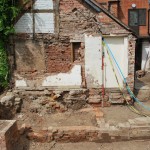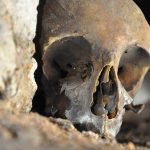On the 26th of March 2016, Channel 4 premiered the TV documentary Secret History: Shakespeare’s Tomb. The programme followed the research project by the Centre of Archaeology who are investigating the grave of the famous playwright and poet William Shakespeare. Watched by 1.4 million people, and due for release across the globe, the show focused upon the results of the first ever archaeological investigation over the Shakespeare family gravestones at Holy Trinity Church in Stratford-upon-Avon. Full publications will follow, but a short summary of the work can be found below.
GOOD FREND FOR IESUS SAKE FORBEARE,
TO DIGG THE DVST ENCLOASED HEARE.
BLESTE BE YE MAN YT SPARES THES STONES,
AND CVRST BE HE YT MOVES MY BONES.
These immortal words, certainly one of the most famous epitaphs in history, are inscribed on a small, insignificant looking stone in the floor of the chancel of Holy Trinity Church in Stratford-upon-Avon. History records that beneath this stone lies the burial of William Shakespeare. The epitaph, a warning from the bard of a curse should anyone disturb his bones. Despite an entry in the church records documenting his burial on the 25th of April 1616, there are a great deal of unanswered questions regarding the presence or absence of his burial, the layout, nature and type of his grave, and the relationship between William’s burial and those of his relatives whose tombstones are positioned immediately adjacent to his. Given the importance of the site and the ethical and religious beliefs which must be considered, no previous archaeological investigation had taken place, despite many requests from a host of individual researchers and institutions. Perhaps partly due to this, and the overwhelming interest in Shakespeare on a global level, many myths, legends and stories have arose spanning many centuries on the subject of the presence of the grave, its contents, and tales of grave robbing and disturbance. In 2010, an ambitious research project was initiated to investigate Shakespeare’s grave. Work was directed by the Centre of Archaeology at Staffordshire University and assisted by a team of leading experts in the fields of archival research (Bob Bearman), Ground Penetrating Radar (Erica Utsi, EMC Radar Consulting), laser scanning and 3-D modelling (Mick Britton, Staffordshire University, and osteology and facial reconstruction and (FaceLab, Liverpool John Moores University). Permission was granted, for the first time, to undertake an innovative non-invasive archaeological investigation of the chancel floor at Holy Trinity using state of the art radar technology aimed at answering many of the questions surrounding this important place. The outstanding results from the work at Holy Trinity also prompted another forensic investigation at the church of St Leonard’s in Beoley, Worcestershire, and in particular an unidentifiable skull held in the Sheldon Crypt deep beneath the church. This summary discusses the results from this project whilst further research is being undertaken in advance of the final project publication later in 2016.
Key findings:
- The GPR survey found that William Shakespeare, his wife Anne Hathaway and other members of the family whose ledger (grave) stones lie beside his, were not buried in a large family vault deep underground, as has long been thought, but in shallow graves beneath their tombstones.
- Each grave is shallow in depth, less than 3 feet, and there is no evidence of coffins.
- There is evidence of a mysterious and significant repair to the head end of William Shakespeare’s grave, leading to Kevin Colls’ theory that this localised repair was needed to correct a sinking of the floor possibly caused by a previous disturbance to the grave.
- Kevin Colls believes these findings give new credence to a story published in The Argosy magazine in 1879, hitherto dismissed as fiction, which claimed that Shakespeare’s skull was stolen from his shallow grave by trophy hunters in 1794.
- William Shakespeare’s grave was found to be significantly longer than his short stone – extending west towards the head end, making it the same size as, and in line with, the other family graves. (Anne’s grave is also longer than her stone suggests.
The Beoley Skull Investigation
The investigation at Holy Trinity led the team to another Church, St Leonard’s, in the Worcestershire village of Beoley, 15 miles from Stratford. Here, in a dark, sealed crypt lies a mysterious skull which legend records is the skull of William Shakespeare. The team were granted access to the crypt to laser scan the skull and carry out a forensic anthropological analysis. The results revealed that this skull belonged to an unknown woman who was in her seventies when she died.
Notes
Permission to carry out the investigation was granted by Holy Trinity Church, Stratford and the Diocese of Coventry. The investigation is a joint collaboration between Staffordshire University and Arrow Media. The archaeological fieldwork carried out at Holy Trinity was part of a wider programme led by Kevin Colls which included archival and documentary research into the grave and laser scanning at the site.
Previously Kevin Colls led the recent archaeological excavation at New Place, the site of Shakespeare’s home in Stratford-upon-Avon. This hugely important dig, commissioned by the Shakespeare Birthplace Trust, found the remains of what would have been the town’s biggest family residence. As well as finds including an oven, a chimney hearth, and a brewhouse, the dig revealed the house, purchased by Shakespeare in 1597, would have had as many as 30 rooms, a great chamber and gallery, as well as evidence of grand feasting: tantalising glimpses into the playwright at the height of his success.
Geophysicist Erica Utsi is an internationally recognised expert in Ground Penetrating Radar, and a Member of the International Advisory Board for GPR 2016. She worked on a major GPR survey of Westminster Abbey, locating long lost graves beneath the floor, including that of Edward the Confessor’s.







